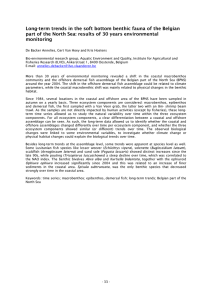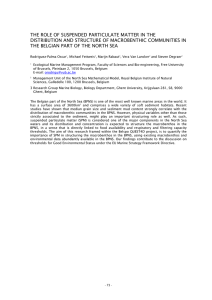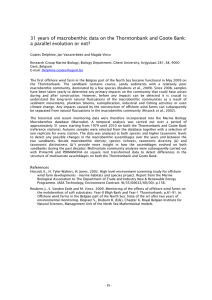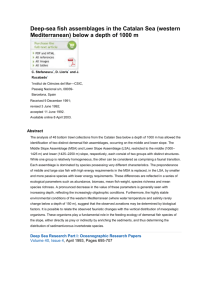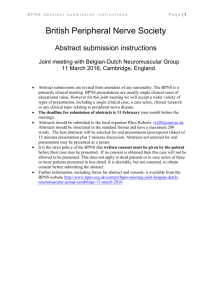Not to be cited without prior reference to the authors
advertisement
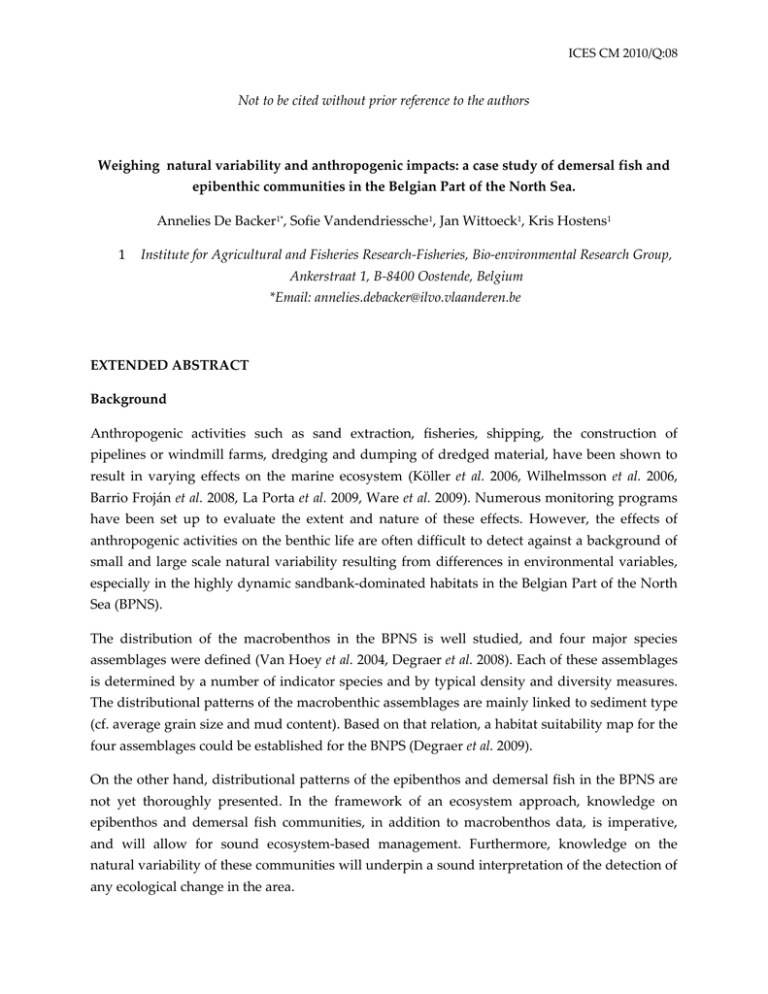
ICES CM 2010/Q:08 Not to be cited without prior reference to the authors Weighing natural variability and anthropogenic impacts: a case study of demersal fish and epibenthic communities in the Belgian Part of the North Sea. Annelies De Backer1*, Sofie Vandendriessche1, Jan Wittoeck1, Kris Hostens1 1 Institute for Agricultural and Fisheries Research-Fisheries, Bio-environmental Research Group, Ankerstraat 1, B-8400 Oostende, Belgium *Email: annelies.debacker@ilvo.vlaanderen.be EXTENDED ABSTRACT Background Anthropogenic activities such as sand extraction, fisheries, shipping, the construction of pipelines or windmill farms, dredging and dumping of dredged material, have been shown to result in varying effects on the marine ecosystem (Köller et al. 2006, Wilhelmsson et al. 2006, Barrio Froján et al. 2008, La Porta et al. 2009, Ware et al. 2009). Numerous monitoring programs have been set up to evaluate the extent and nature of these effects. However, the effects of anthropogenic activities on the benthic life are often difficult to detect against a background of small and large scale natural variability resulting from differences in environmental variables, especially in the highly dynamic sandbank-dominated habitats in the Belgian Part of the North Sea (BPNS). The distribution of the macrobenthos in the BPNS is well studied, and four major species assemblages were defined (Van Hoey et al. 2004, Degraer et al. 2008). Each of these assemblages is determined by a number of indicator species and by typical density and diversity measures. The distributional patterns of the macrobenthic assemblages are mainly linked to sediment type (cf. average grain size and mud content). Based on that relation, a habitat suitability map for the four assemblages could be established for the BNPS (Degraer et al. 2009). On the other hand, distributional patterns of the epibenthos and demersal fish in the BPNS are not yet thoroughly presented. In the framework of an ecosystem approach, knowledge on epibenthos and demersal fish communities, in addition to macrobenthos data, is imperative, and will allow for sound ecosystem-based management. Furthermore, knowledge on the natural variability of these communities will underpin a sound interpretation of the detection of any ecological change in the area. A monitoring strategy based on medium-term data acquisition at fixed locations is used to define demersal fish and epibenthos communities and to evaluate their natural spatial and temporal variability in the BPNS. In total, 80 locations spread over the BPNS were sampled with an 8 m shrimp trawl during 1 to 9 (spring and autumn) campaigns between 2004 and 2009. Five tracks are located in sand extraction areas, five in dredge dumping sites and two in windmill areas, and could thus be defined as impact locations, while 68 tracks are regarded as reference locations. A number of environmental variables were used in the analysis of the spatial distribution of the encountered species. Results 1) Characterisation of the species assemblages and distributional patterns The coastal - offshore transition is the dominant structuring factor on a regional scale (BPNS), which is reflected by a shift from a coastal system characterised by shrimp, ophiuroids and crabs to an offshore system with lesser weever, hermit crabs and dab (Fig. 1). The transition between coastal samples and offshore samples was consistent over the years and seasons. a 2b Figure 1: MDS plot with indication of the defined species assemblages (left) and characterisation of the species assemblages by average density, number of species and characteristic species (right) Within the coastal zone, three groups could be distinguished based on a cluster analysis and visualised in an MDS plot (Fig. 1), which mainly differed in the occurrence and densities of Ophiura ophiura, Ophiura albida, Crangon crangon, Liocarcinus holsatus and Nassarius reticulatus: Coastal 1 is found in the western part of the coastal area and a bit more offshore at the eastern part (Fig. 2). This assemblage, characterized by the species O. ophiura, C. crangon and L. holsatus, showed the highest densities (mean 2085 ind./1000 m²) and a high diversity (mean N° of species 2 (S): 25; mean N1: 4.4) (Fig. 1). The spatial extent of this group was consistent over the years, and it coincides with the potential habitat of the diverse macrobenthic Abra alba community, which is characteristic for muddy fine sand (mean mud content 5.8% and mean median grain size 219 µm) (Fig. 2). Coastal 2a is found between the harbour of Ostend and the Belgian-Dutch border (eastern coastal zone), extending offshore to the Vlakte van de Raan (Fig. 2). ‘Coastal 2a’ samples are predominantly spring samples exhibiting the lowest density values of the BPNS (mean density 36 ind./1000 m²) and low diversity values (mean S: 14.7; mean N1: 3.7). The top characteristic species were C. crangon, Pomatoschistus sp. and O. ophiura (Fig. 1). Coastal 2b has a similar spatial distribution as ‘coastal 2a’, although contributing samples are most frequently found closer to the shore. The samples constituting this group were characterized by the species C. crangon, L. holsatus and O. ophiura. This is mainly an autumn assemblage exhibiting intermediate values of density and low diversity values, similar to the ones of ‘coastal 2a’ (mean density 353 ind./1000 m²; mean S: 19.1; mean N1: 3.6). Both ‘coastal 2’ assemblages overlap mainly with the potential habitat of the, likewise less diverse, Macoma balthica community occurring in muddy sediments (mean median grain size 95 µm) (Fig. 2). Within the offshore samples, two subgroups are defined based on varying densities of C. crangon, Echiichthys vipera and O. albida. The offshore assemblages coincide with the macrobenthic Nephtys cirrosa and Ophelia limacina communities, both characterized by low densities and low species richness and respectively occurring in fine to medium sands (mean median grain size: 274 µm) and medium to coarse sands (mean median: 409 µm). Offshore 1 samples are mostly found in the most remote parts of the BPNS (except in spring 2006, during which even the most remote stations are characterized by the ‘offshore 2’ community). The samples belonging to ‘offshore 1’ all exhibit low densities (mean density 37 ind./1000 m²), but a relatively high species number and evenness (mean S: 23.6, mean N1: 7.3). The top characteristic species were E. vipera, Pagurus bernhardus and O. albida. Offshore 2 is characterized by the species C. crangon, P. bernhardus and O. albida, and combines the higher densities found in coastal samples with the high diversity found in genuine offshore samples (mean density 111 ind./1000 m²; mean S: 27.2; mean N1: 8.3). Several samples in the spatial range of the ‘offshore 2’ zone are inconsistently placed in one of the offshore assemblages over years and seasons. Part of this inconsistency is induced by yearly varying water temperatures influencing the species distribution, and part by differences between sandbank tops and gullies within the sandbank systems of the offshore region. 3 Figure 2: Overlay of demersal fish and epibenthos communities per sampling station on the macrobenthos habitat suitability map (from Degraer et al. 2009) of the BPNS for spring (left) and autumn (right). 2) Main structuring variables The distLM results (based on BIC criterion and BEST selection) (Permanova +, Anderson et al. 2008) showed that 40.5% of the biological variation could be explained by a combination of the variables distance to the coast, temperature, depth, mud percentage, median grain size of the sand fraction and salinity (Fig. 3). In other words, both site specific and temporal conditions were identified as important structuring factors. Distance was the most important variable, accounting for 25.7% of the explained variation. This again indicates the importance of the coastal - offshore transition on the regional (BPNS) scale, whilst defining epibenthos – demersal fish assemblages. Distance was followed by temperature explaining 5.3%, emphasizing the differences between spring and autumn samples, which are separated per community on the second axis in the dbRDA plot (Fig. 3). ‘Impact’ was as well entered as a categorical variable, but was not retained as an explanatory variable for the distribution patterns of the epibenthos and fish assemblages of the whole BPNS. However, on small spatial and temporal scales, some differences between impact and reference zones were noted (Vandendriessche et al. in prep). These small scale differences need to be further investigated. 4 Figure 3: Distance based RDA showing the environmental variables explaining part of the variation observed in the epibenthos and demersal fish communities (S: spring samples; A: autumn samples). Conclusion Knowledge of the natural spatio-temporal dynamics of the reference conditions is a major advantage for future quantification of anthropogenic impacts and also for the evaluation of the relevance of these impacts. This study shows that to optimize the impact assessment and filter out the natural variability in the BPNS, it is imperative that both control and impact samples belong to the same epibenthic and demersal fish assemblage. Moreover, to exclude the observed seasonal variation, impact and control samples should be taken in the same period of the year to minimize temporal dynamics. Furthermore, we find geographical evidence for close overlap between the macrobenthos and the epibenthos-demersal fish communities in the BPNS. To find out whether these ecosystem components react differently on the diverse human impacts, it is very valuable to assess the biological status of both ecosystem components and examine the impact of anthropogenic activities through different trophic levels of the ecosystem. On the spatial scale of the BPNS, the small scale impact of human activities on epibenthic and demersal fish assemblages fades away into the background of natural variability. This is actually a good sign, since the anthropogenic impacts do not push the ecosystem outside the natural limits. However, to unravel the long term and small scale impacts, more detailed studies are needed, taking into account the above mentioned requisites. 5 References Anderson MJ, Gorley RN & Clarke KR (2008). PERMANOVA + for PRIMER: Guide to software and statistical methods. PRIMER-E: Plymouth, UK. Degraer S, Verfaillie E, Willems W, Adriaens E, Vincx M & Van Lancker V (2008). Habitat suitability modelling as a mapping tool for macrobenthic communities: An example from the Belgian part of the North Sea. Continental Shelf Research 28(3): 369-379, doi: 10.1016/j.csr.2007.09.001. Degraer S, Braeckman U, Haelters J, Hostens K, Jacques T, Kerckhof F, Merckx B, Rabaut M, Stienen E, Van Hoey G, Van Lancker V & Vincx M (2009). Studie betreffende het opstellen van een lijst met potentiële Habitatrichtlijn gebieden in het Belgische deel van de Noordzee. Eindrapport in opdracht van de Federale Overheidsdienst Volksgezondheid, Veiligheid van de Voedselketen en Leefmilieu, Directoraat-generaal Leefmilieu. Brussel, België, pp. 93 Barrio Froján CRS, Boyd SE, Cooper KM, Eggleton JD & Ware S (2008). Long-term benthic responses to sustained disturbance by aggregate extraction in an area off the east coast of the United Kingdom. Estuarine, Coastal and Shelf Science 79: 204-212 Köller J, Köppel J & Peters W (2006) Offshore wind energy: research on environmental impacts. Springer-Verlag Berlin Heidelberg, pp 371 La Porta B, Targusi M, Lattanzi L, La Valle P, Paganelli D & Nicoletti L (2009). Relict sand dredging for beach nourishment in the central Tyrrhenian Sea (Italy): effects on benthic assemblages. Marine Ecology 30: 97-104 Vandendriessche S, De Backer A, Wittoeck J & Hostens K (in prep.) Natural versus anthropogenically induced variability within communities of demersal fish and epibenthos in the Belgian Part of the North Sea: implications for impact monitoring. Van Hoey G, Degraer S & Vincx M (2004). Macrobenthic community structure of soft-bottom sediments at the Belgian Continental Shelf. Estuarine Coastal and Shelf Science 59: 601-615 Ware S, Bolam SG & Rees HL (2009). Impact and recovery associated with the deposition of capital dredging at UK disposal sites: lessons for future licensing and monitoring. Marine Pollution Bulletin 60:79-90 Wilhelmsson D, Malm T & Öhman MC (2006). The influence of offshore windpower on demersal fish. ICES Journal of Marine Science 63:775-784, doi10.1016/j.icesjms.2006.02.001 6
